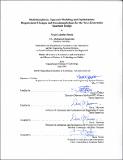| dc.contributor.advisor | Joseph H. Saleh and Dava J. Newman. | en_US |
| dc.contributor.author | Jordan, Nicole Catherine | en_US |
| dc.contributor.other | Massachusetts Institute of Technology. Technology and Policy Program. | en_US |
| dc.date.accessioned | 2007-01-10T15:36:16Z | |
| dc.date.available | 2007-01-10T15:36:16Z | |
| dc.date.copyright | 2006 | en_US |
| dc.date.issued | 2006 | en_US |
| dc.identifier.uri | http://hdl.handle.net/1721.1/35296 | |
| dc.description | Thesis (S.M.)--Massachusetts Institute of Technology, Dept. of Aeronautics and Astronautics; and, (S.M.)--Massachusetts Institute of Technology, Engineering Systems Division, Technology and Policy Program, 2006. | en_US |
| dc.description | This electronic version was submitted by the student author. The certified thesis is available in the Institute Archives and Special Collections. | en_US |
| dc.description | Includes bibliographical references (p. 101-111). | en_US |
| dc.description.abstract | The ability for crew members to perform spacewalks is an essential component of human spaceflight. Spacewalks are absolutely crucial for planetary exploration because they enable astronauts to explore their environment, conduct scientific experiments on the planetary surface, construct space-based infrastructure, and perform maintenance activities. The spacesuit is the primary piece of enabling hardware for spacewalks. Given that the United States is embarking on an ambitious mission to return to the Moon and eventually travel to Mars (as mandated by the U.S. Vision for Space Exploration), a new spacesuit will be built. The objective of this thesis is to aid the designers of the next generation spacesuit through critical analysis of existing spacesuits and quantitative optimization of future spacesuit architectures. Spacesuits change substantially over their design lifetimes; for example, the American spacesuit, the Extravehicular Mobility Unit (EMU) has undergone over five hundred changes in its twenty-five year operational life. These design changes have been triggered by requirement changes, which in turn were mandated by political and technological changes in the system's environment. | en_US |
| dc.description.abstract | (cont.) This observation points to the fact that the next generation spacesuit must be designed with the ability to cope with the likelihood of changing requirements after it has been fielded. This goal, as I show in this thesis, can be accomplished in two steps: first, the system designer must have an understanding of what requirement changes are likely to occur; second, quantitative analysis can be used to determine how requirement changes affect the design and subsequently what designs can more readily accommodate change. This thesis is divided into two parts that map into the two steps. Part I is comprised of a comparative analysis of the EMU and Russian Orlan spacesuits. In order to understand how the spacesuits have changed, I propose a change framework that links changes in a system's environment to changes in its requirements, which in turn necessitate design changes. In Part I, I trace a single environment change, the use of the Shuttle EMU aboard the International Space Station (ISS), to ten requirements changes that resulted in a multitude of EMU design changes. | en_US |
| dc.description.abstract | (cont.) This section finds that the divergence of the American and Soviet spaceflight programs in the late 1970s, with the Americans concentrating on the Shuttle and the Soviets on station-based flight, is essential to understanding differences in American and Soviet/Russian spacesuit design. Because of the Soviet/Russian space program's experience with long-duration, station-based spaceflight, the Orlan spacesuit was able to more readily adapt to the ISS environment. Whereas Part I looks back at the evolution of spacesuit architectures, Part II looks ahead toward the future of spacesuit design. The second part of the thesis discusses the development of a multidisciplinary spacesuit model and uses an N-Branch Tournament Genetic Algorithm to optimize the spacesuit design vector for mass, mobility, and pre breathe time. Because the model used for this optimization is multidisciplinary, fundamental tensions in spacesuit design are captured that have not before been explored with existing single-discipline models. Part II finds that the optimal spacesuit garment is different in microgravity than on the planetary surface because the desired mobility is different. Taken as a whole, this thesis offers a comprehensive evaluation of spacesuit design and evolution, and should prove useful in the design of the next-generation spacesuit. | en_US |
| dc.description.statementofresponsibility | by Nicole Catherine Jordan. | en_US |
| dc.format.extent | 129 p. | en_US |
| dc.format.extent | 13695030 bytes | |
| dc.format.extent | 13694497 bytes | |
| dc.format.mimetype | application/pdf | |
| dc.format.mimetype | application/pdf | |
| dc.language.iso | eng | en_US |
| dc.publisher | Massachusetts Institute of Technology | en_US |
| dc.rights | M.I.T. theses are protected by copyright. They may be viewed from this source for any purpose, but reproduction or distribution in any format is prohibited without written permission. See provided URL for inquiries about permission. | en_US |
| dc.rights.uri | http://dspace.mit.edu/handle/1721.1/7582 | |
| dc.subject | Aeronautics and Astronautics. | en_US |
| dc.subject | Technology and Policy Program. | en_US |
| dc.title | Multidisciplinary spacesuit modeling and optimization : requirement changes and recommendations for the next-generation spacesuit design | en_US |
| dc.type | Thesis | en_US |
| dc.description.degree | S.M. | en_US |
| dc.contributor.department | Massachusetts Institute of Technology. Department of Aeronautics and Astronautics | |
| dc.contributor.department | Massachusetts Institute of Technology. Engineering Systems Division | |
| dc.contributor.department | Technology and Policy Program | |
| dc.identifier.oclc | 74670206 | en_US |
